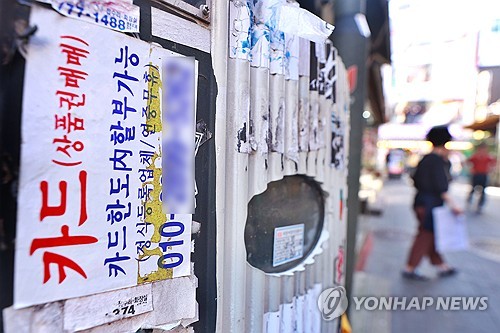
(Seoul=Yonhap Infomax) Dong Kyu Heo – The gap between the average card loan interest rate offered by South Korean credit card companies and the rate charged to low-credit borrowers widened to its largest margin this year in October.
Industry analysts note that while card issuers have lowered rates for high-credit customers, they have simultaneously raised rates for those with lower credit scores, increasing the interest burden for vulnerable borrowers and raising barriers to card loan access.
According to the Credit Finance Association of Korea on the 26th, as of end-October, the average card loan interest rate at the seven major card issuers—Samsung Card, Shinhan Card, KB Kookmin Card, Hyundai Card, Lotte Card, Hana Card, and Woori Card—stood at 13.80%, down 0.18 percentage points from 13.98% at the end of September.
Card loan rates have been on a steady decline since February, with most card companies recording their lowest annual rates in October compared to the previous month.
Woori Card posted the largest drop among the seven, with its average card loan rate falling by 0.44 percentage points, followed by Hana Card and KB Kookmin Card, which saw declines of 0.43 and 0.39 percentage points, respectively.
The decline in average card loan rates in October is largely attributed to rate cuts for high-credit borrowers. Specifically, card loan rates for members with credit scores above 900 fell by up to 0.53 percentage points from September, while those with scores between 800 and 900 saw reductions of up to 0.81 percentage points.
In contrast, the average card loan rate for borrowers with credit scores below 700 actually rose from 17.15% to 17.21% during the same period, an increase of 0.06 percentage points.
As a result, the gap between the overall average card loan rate and the rate for borrowers with credit scores below 700 widened to 3.41 percentage points in October, marking the largest disparity so far this year.
Most card issuers saw a slight month-on-month increase in this gap, with three out of the seven companies posting differences of more than 4 percentage points. Hyundai Card recorded the largest gap at 4.69 percentage points, followed by Woori Card at 4.2 and Samsung Card at 4.05 percentage points.
This growing divergence in card loan rates between high- and low-credit borrowers is seen as a result of card companies focusing on safer, low-risk customers to better manage delinquency rates. This trend has been reinforced by tighter household lending regulations introduced by the Financial Services Commission (FSC) on June 27 and the phased implementation of the stricter Debt Service Ratio (DSR) rules, which have curbed the growth of card loan assets and led to a shrinking borrower base even as delinquencies rise.
“Recently, card companies have been expanding card loan marketing to high-credit customers by offering rate discounts, while the threshold and interest burden for vulnerable borrowers have increased,” said an industry official.
dghur@yna.co.kr
(End)
Copyright © Yonhap Infomax Unauthorized reproduction and redistribution prohibited.

